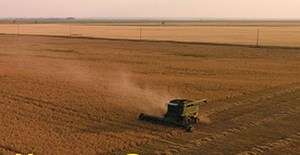HUMBOLDT — Despite precipitation causing harvest delays over the past week, harvest has progressed to 65 per cent complete within the region which is up from the 58 per cent reported last week. This is slightly behind the five-year average of 66 per cent but ahead of the 10-year average of 56 per cent.
Harvest is complete for winter cereals, triticale, durum, and field peas within the region. For spring-seeded cereal crops, barley leads harvest progress with 89 per cent complete followed by spring wheat at 80 per cent and oats at 65 per cent. Canary seed currently sits at 56 per cent harvested. Lentils are currently 86 per cent harvested in the region followed by chickpeas at 75 per cent harvested and soybeans are 50 per cent complete. Canola currently sits at 34 per cent harvested and flax is 18 per cent harvested within the region.
Rain fell throughout the region in varying amounts over the past week. The highest rainfall recorded fell in the Tisdale and Hudson Bay areas at 29 mm followed by the Rosthern area at 28 mm. The Star City and Duck Lake areas both received 27 mm.
The recent precipitation has improved pastures and topsoil moisture conditions within the region. Currently, cropland topsoil moisture is rated as 73 per cent adequate, 25 per cent short and two per cent very short. Hayland is rated as 66 per cent adequate, 25 per cent short and nine per cent very short. Pasture topsoil moisture is rated as 61 per cent adequate, 29 per cent short and 10 per cent very short. Producers are hopeful for more precipitation following harvest to further assist with replenishing topsoil moisture within the region.
As producers evaluate livestock water supplies, 76 per cent indicate that there are no shortages occurring or anticipated, with 14 per cent indicating moderate shortages are occurring and 10 per cent are anticipating a shortage depending on conditions throughout the fall. Additionally, 95 per cent of producers reported no concerns presently with water quality for their livestock.
Crop damage over the past week was mainly due to wind, waterfowl, wildlife and grasshoppers but with overall minor damage reported. The recent rain has also caused further challenges for lodged crops, along with concerns for reduced quality of unharvested crops within the region. Producers are also busy with spraying for fall weed control, harrowing, baling, hauling bales, cleaning corrals and fencing.
For more information about Northeastern Saskatchewan, explore the .
|
Northeast Saskatchewan |
|
|
Census Division |
Per cent Harvested |
|
14 |
61 |
|
15 |
69 |
|
Region Average |
65 |




